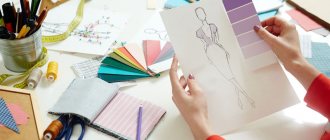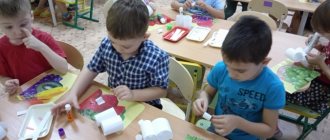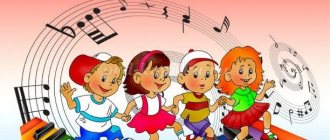Summary of the drawing lesson “Ducklings are swimming along the river”
Natalya Pechnikova
Summary of the drawing lesson “Ducklings are swimming along the river”
Main objectives of the lesson:
• consolidate ideas about ducks and ducklings, their body parts, color
• consolidate the ability to distinguish and name (if possible) colors (yellow, red, blue, black)
• improve the ability to paint an image in a given color scheme, following the outline
• practice the ability to supplement a drawing with missing elements
How to make the applique “Fluffy chicken in the meadow”
This is a lesson for the preparatory group of kindergarten or 1-2 grades. For younger children, you will need to prepare paper circles in advance; students can cut them out themselves. During the process, the child trains to make identical cuts with scissors, which form a fluffy edge of the product.
Step 1 . Take a pencil and yellow colored paper. Using a nearby material, such as a milk bottle cap, make three circles.
Step 2 . Make a small cut from the edge to the center of the circle. Then continue cutting the circle, making equal cuts at approximately equal distances. Finish the fringe all the way around.
Step 3 . Decorate the second circle in the same way. Additionally, make a third blank for the wing by cutting the third circle in half. On all workpieces, gently squeeze out the fringe with your fingers so that the workpiece appears fluffy.
Step 4 . The chicken legs can be made according to the pattern below, or you can cut out two small triangles. It is necessary to cut out the eye - a small black circle and the beak (a thin strip of red).
Step 5 . Glue the circles onto a piece of paper or cardboard so that one overlaps the other slightly. Attach the eye to the top circle.
Step 6. Glue the legs, beak and wing made from half a circle step by step.
Tip: you can make a dandelion on the lawn in a similar way.
Notes on drawing in the senior speech therapy group “Ducklings swim in the pond”
Larisa Semyonova
Notes on drawing in the senior speech therapy group “Ducklings swim in the pond”
• Continue to introduce children to the poke drawing ;
• Improve the ability to draw with the end of a brush , draw with a felt-tip pen ;
• Learn to draw ducklings swimming in water , independently determining their number;
• Strengthen knowledge about the structure of birds, the ability to solve riddles;
•Activate vocabulary: migratory, ducklings , flock, body, head, wings, tail, paws, beak, feathers, grass, cattail, waves, etc.;
• Foster cognitive interest in nature.
Materials for the lesson: blue A4 paper, gouache paints (yellow, ocher, red, green, brown, blue, black felt-tip pen, brushes, rags, water, ducklings’ hats, ball , book by K. Ushinsky “Hen and Ducklings ”
.
Preliminary work: observing birds on a walk, feeding the birds, reading V. Suteev’s fairy tale “The Chicken and the Duckling”
, story by K. Ushinsky
“Ducks”
.
House on the Internet
Your mother's or grandmother's birthday is approaching (although it is not March 8 , you still need a gift) .
What can a child give to his grandmother or mother for his birthday (or on March 8th ) - This question is always relevant.
The topic of today's post is a simple answer to this question.
The child is invited to make an applique - a duckling .
younger child from 2 to 4 years old ) , as a gift to his mother or grandmother, duckling template on a white sheet and use it as a coloring book .
child ( from 4 to 8 years old ) , as a gift to his mother or grandmother, you can print out a black and white template on colored paper and make an applique according to the given color sample of a duckling.
For a child aged ( from 8 to 13 years old ) , as a gift to his mother or grandmother, the printed black and white template needs to be transferred through tracing paper to fabric (for example, fleece) and together with one of the adults, using a sewing machine, make the duckling applique given on the image.
The resulting masterpiece can be immortalized in the form of a duckling mask .
For adults, it’s better to turn making a duck mask into an educational game . The following will help you with this: a printer, perhaps acrylic pearlescent paints with glitter effects, a laminator (if you have one, of course - if you don’t, you can attach the product to thick cardboard) and an elastic band or a piece of rope.
So, together with the children we will make a duckling mask with our own hands.
1. You need to save the duck mask to your computer.
2. Paste the saved mask template into a text editor (for example, Word) and stretch it onto an A4 sheet.
3. Print out the duck mask .
4. Give the child the opportunity to creatively color the duckling mask (it is better to use professional acrylic pearlescent paints with glitter effects, silver or gold effects (they can be found in an art salon), as well as special gels with shiny elements (sold in stationery stores)).
In the case of colored paper appliqué, let your child do everything himself!
5. After duckling mask has dried, it is better to laminate it and cut it along the contour.
If your duckling mask is made of fleece, then that's even better - just attach a rope to it that is the size of your child's head.
Below are duck mask templates and applique designs made from colored paper and fleece.
We make the applique with our own hands together with the children. Duckling applique. Gift for grandma, gift for mom
We make the applique with our own hands together with the children. Duckling applique. A gift for grandma, a gift for mom. Application made of colored paper
We make the applique with our own hands together with the children. Duckling applique. A gift for grandma, a gift for mom. Fleece applique
Together with the children, we make a children's carnival duckling mask out of paper with our own hands. Paper duck mask
We make an application - a mask with our own hands together with the children. Applique - duckling mask. Gift for grandma, gift for mom
Making chicken from cotton balls
This workshop is a great way to spend time with your child.
To complete this work you will need cotton wool, yellow gouache, colored cardboard, pencil and glue. At the first stage, trace the baby’s palms, placing them on yellow paper. Make legs and beak from red paper.
Make an oval out of cardboard - the base of the chicken's body. Tear off pieces of cotton wool. Roll them into balls and stick them on the surface.
After filling out the entire template, apply yellow gouache. You can use cotton swabs. Let the workpiece dry.
Glue the wing palms on the wrong side. Complete the craft: glue on the paws, beak and eyes.
Tip: make a composition “Cockerel, hen and chickens are walking in a clearing.” Make wings from stencils of the palms of all family members.
Adviсe
Children are happy to use non-traditional materials in their work, for example, a beautiful figure of a chicken is made from millet glued inside the outline, from plasticine, threads, and wool. Egg shells can also be used in the application. Interesting pictures are obtained in the format of combining drawing and gluing.
Such classes are already carried out in the second junior group. To do this, adults need to print out a chicken template for applique, and little craftsmen will fill the surface themselves.
In a preschool or at home, you can use colored sawdust, stick chickens from cotton pads, make crafts from cereals or from paper napkins, filling in the drawn sketch with them. For children of preschool or primary school age, we recommend the following application made from napkins and PVA glue:
If you are planning a technology lesson for primary school children, make an applique out of fabric. Include elements made from yarn, such as grass from cut threads.
Before class, do not forget to discuss with your children the rules for safe work with scissors and glue, and remind them to be careful. Be sure to praise the final result.
Add or change our instructions as you wish. Multi-colored paper gives a real flight of creativity: you can make three-dimensional figures from cylinders, tubes and spirals, you can create multi-figure scenes: a hen with chicks, chicks in a shell, in a nest or in a basket, birds in a clearing or on a branch.
You can download and print the drawing or coloring you like and make your own diagram for the applique. Everything will work out if you use your imagination and train more often.
©WorldPositive
Layout "Ducks with ducklings in the pond"
Ksenia Yaichkina
Layout "Ducks with ducklings in the pond"
Layout "Ducks with ducklings in the pond"
Materials: box, sponge, toothpicks, paper ducks, pencils/markers/wax pencils/paints, glue, colored (green) paper.
This work was carried out in an older group with children 5 years old.
The children and I made a pond for ducks (model).
The guys play with this layout almost every day. They like it. that our pond is divided into separate parts, thanks to which they create a plot for their ducks. They visit each other, play hide and seek, and the ducklings learn to swim.
This layout was made according to the program “Worlds of Childhood. Constructing Opportunities."
Summary of educational activities for children with mild mental retardation 3 years of training in sculpting “Duck with Ducklings” Municipal government preschool educational institution of Shelekhovsky district “Kindergarten No. 1 “Buratino” 1.1. Full name I. O. Gribova Yulia Sergeevna.
GCD summary. Modeling “Fish in a Pond” Summary of GCD: Modeling Fish in a Pond. Program content: Develop interest in sculpting, reinforce the technique of careful sculpting. Teach children to roll. Notes on drawing in the senior group “Ducks are swimming” Topic: “Ducks are swimming” Educational areas: artistic and aesthetic development, speech development, physical development. Tasks:. Layout "Fish swim in the pond." Master class from acorns using chenille wire You can make miniature fish from acorns and chenille wire, and then use them to decorate a pond model. Purpose:
GCD for the application “Swans on the Pond” Summary of GCD for the application “Swans on the Pond” (senior group) Goals: continue to teach children silhouette cutting, teach methods and techniques.
GCD for the application “Swans on the Pond” Summary of GCD for the application “Swans on the Pond” (senior group) Goals: continue to teach children silhouette cutting, teach methods and techniques.
GCD in the junior group “Our ducks in the morning” Purpose: To introduce the content, teach to understand the content, repeat after the teacher, find the duck among the animals. Teach drawing.
Summary of a lesson on speech development in the second junior group “Journey of a Duck” Scenario of a lesson on speech development in the 2nd junior group “Journey of a Duck” Compiled by Nesterova E. V., Osokina E. V. Purpose: Formation.
Lesson on speech development in the first junior group “Duck with ducklings” Lesson on speech development in the first junior group “Duck with ducklings”. Target. Teach children to look at a picture that shows someone they know.
Source
Easter chicken in an egg using applique technique
You can make a very beautiful paper applique if you create compositions using various geometric shapes. By assembling an image from circles, triangles, ovals, trapezoids, students consolidate their design and imaginative thinking skills. Use a variety of cutting techniques: zigzag, wavy, circular.
Children usually enjoy participating in the preparations for Easter. Children are often asked to decorate an Easter egg cut out of cardboard or paper. We offer another way to create a holiday card.
Prepare 2 flat egg-shaped pieces. It’s easy to draw an egg; just trace the top of the spoon with a pencil. You also need a strip of green paper and 3 triangles of yellow, red and orange.
Make a chicken comb out of the red triangle by cutting off its base using wavy movements of the scissors.
Cut the top of the orange triangle into a semicircle, and shape its base in the form of semicircular feathers. This will be a wing. Cut the base of the yellow workpiece (wing) in the same way. While cutting, turn the workpiece in your hands for convenience.
Cut off the two bottom corners of the green strip diagonally, so that you get an inverted trapezoid. Cut the top edge with cloves.
Using a zigzag line, cut a white paper egg in half.
Let's start assembling the chicken figurine: glue the eye and wing onto the egg-shaped blank. Glue a comb, a tail and a beak made from scraps of materials to its inner part. Place the finished composition in the center of a sheet of paper or cardboard.
Then stick on the grass from the green blank.
Place shell halves made of white paper on the sides as shown in the photo. The chick, hatched from the egg, is ready.
Chicken using cut applique technique
This step-by-step master class is for children of any age. The cut appliqué for children of the younger group is different in that the pupils partially paste over pre-prepared parts. Children in the middle group fill only the chicken figure with scraps. For the older group, the task is a little more complicated: they need to complete the composition.
Children who are proficient in the appliqué technique make the composition themselves according to the description from start to finish.
For convenience, make a template of the chicken body on which you will perform the appliqué. To get a symmetrical shape, fold a sheet of yellow paper in half and cut out two semicircles, one larger, the other smaller.
Place the resulting blank in the center of a sheet of colored paper, glue it, then tear the sheet of yellow paper into long strips.
Tear the resulting strips into small elements as shown in the photo. You can come up with your own way of tearing paper. Begin gradually gluing small parts to the resulting silhouette.
For young children attending nurseries, the torn technique is not easy for them, so it will be enough if they decorate a red comb and breast.
It will not be difficult for older children to cover the resulting figurine completely. From the remaining long strips, make wings, each of which consists of three feather elements.
Make eyes from two blue particles, and a beak from red paper.
Invite your child to decorate the composition: make paws from short red particles, and blades of grass from long ones. The work is ready.
It will turn out very beautiful if you do it as a team. Then cheerful chickens in the meadow will decorate the group and will cheer up everyone: the teacher, children, parents.





